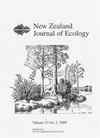国际上利用外来种植园恢复原生森林及其对新西兰奥特亚的影响
IF 1.4
3区 环境科学与生态学
Q3 ECOLOGY
引用次数: 0
摘要
:国际上对生态系统恢复和原生森林扩张的渴望日益高涨。过渡林业是一种潜在的原生森林恢复和固碳方法,将外来人工林转变为原生森林,这在新西兰奥特亚越来越引起人们的兴趣。然而,目前尚不清楚这种方法是否能产生一个永久的原生森林生态系统,以及它能在多大程度上代表残留的原生森林。本文探讨了利用外来人工林促进原生森林恢复的国际研究,特别是影响恢复的生态过程,以及可用于改善森林过渡的管理干预措施。我们发现,景观基质的组成对原生再生有很大影响。将原生植被覆盖率提高到至少25%对外来森林的原生再生有着强烈的积极影响。原生植被覆盖率的增加也提高了种子的有效传播,因为种子来源更多,种子传播距离更短,鸟类种子传播者的栖息地大小和连通性也得到了改善。进一步研究哪些种子进入人工林,以何种方式进入,以及与种子来源的距离,将非常有助于了解外来人工林向原生森林过渡的潜力,以及防止这种情况发生的障碍。树冠操作也被发现是刺激外来种植园中本地物种建立和生长的关键工具,尤其是那些在自然演替中依赖小规模干扰的后期演替物种。在尽量减少干扰的同时逐步移除树冠的实用方法是一个需要进一步研究的领域。我们发现,害虫管理可能是将外来种植园转变为原生森林的关键。草食动物是演替的重要障碍,因为它们可以阻止再生植物中易感物种的生长和存活,并由于优先浏览而对物种组成和森林结构产生重大影响。啮齿动物会消耗种子,阻止植物生长,进一步限制再生。由于鸟类种子传播对许多树种的重要性,捕食本地鸟类的哺乳动物也破坏了森林生态系统。这篇综述强调了对过渡林业进行进一步研究的必要性,以及将外来种植园恢复为原生森林的潜力。必须对整个奥特亚罗阿的各种大气候、森林类型、土壤和地貌进行研究,以确保建议代表区域差异,并尽可能全面。本文章由计算机程序翻译,如有差异,请以英文原文为准。
International use of exotic plantations for native forest restoration and implications for Aotearoa New Zealand
: The desire for ecosystem restoration and native forest expansion is growing internationally. Transitional forestry, where an exotic plantation forest is transitioned to a native forest, is a potential method of native forest restoration and carbon sequestration that is gaining interest in Aotearoa New Zealand. However, it is currently unknown whether this approach can produce a permanent native forest ecosystem and how representative of remnant native forest it could be. This article explores international research into the use of exotic plantations to facilitate native forest restoration, specifically the ecological processes affecting restoration, and management interventions which could be applied to improve the forest transition. We found that the composition of the landscape matrix is highly influential on native regeneration. Increasing native vegetation cover to at least 25% has a strong positive effect on native regeneration within exotic forests. Increased native vegetation cover also improves effective seed dispersal as there are more sources of seed, shorter distances for the seed to travel, and improved habitat size and connectivity for avian seed dispersers. Further research into which seeds are entering plantation forests, by what method, and the distance from the seed source would be highly useful in understanding the potential for exotic plantation forests to transition to a native forest, and what barriers may be preventing this from occurring. Canopy manipulation was also found to be a key tool in stimulating establishment and growth of native species within an exotic plantation, especially those later-successional species which rely on small-scale disturbance in their natural succession. Practical methods of gradual canopy removal while minimising disturbance is an area which requires further research. We found that pest management is likely to be critical for transitioning exotic plantation to native forest. Herbivores present a significant barrier to succession as they can prevent growth and survival of susceptible species of regenerating plants and have significant effects on species composition and forest structure due to preferential browsing. Rodents which consume seeds prevent plants from establishing, further limiting regeneration. Mammals which predate native birds also disrupt the forest ecosystem due to the importance of avian seed dispersal for many tree species. This review highlighted the need for further research into transitional forestry and the potential to revert an exotic plantation to a native forest. Research conducted must occur across a variety of macroclimates, forest types, soils, and landforms throughout Aotearoa to ensure advice represents regional differences and is as comprehensive as possible.
求助全文
通过发布文献求助,成功后即可免费获取论文全文。
去求助
来源期刊

New Zealand Journal of Ecology
环境科学-生态学
CiteScore
3.00
自引率
12.50%
发文量
35
审稿时长
>36 weeks
期刊介绍:
The New Zealand Journal of Ecology is a biannual peer-reviewed journal publishing ecological research relevant to New Zealand/Aotearoa and the South Pacific. It has been published since 1952 (as a 1952 issue of New Zealand Science Review and as the Proceedings of the New Zealand Ecological Society until 1977). The Journal is published by the New Zealand Ecological Society (Inc.), and is covered by Current Contents/Agriculture, Biology and Environmental Science, GEOBASE, and Geo Abstracts.
 求助内容:
求助内容: 应助结果提醒方式:
应助结果提醒方式:


